生い立ち Birth and Early Life
1956年3月6日 兵庫県神戸市垂水区舞子で誕生。小中学生時代は絵画や詩に興味がありましたが才能がありませんでしたので芸術方面には進めませんでした。
兵庫県立伊丹高校、大阪府立大学(現,大阪公立大学)航空工学科 を卒業し1980年 ヤマハ発動機(株)入社。主に商品開発業務を担当、ここで・・・・・
価値の創造、期待されるブランド、信頼の品質とは何たるかを学びました。
I was born on March 6, 1956, in Maiko, Tarumi Ward, Kobe City, Hyogo Prefecture. During my elementary and middle school years, I was interested in painting and poetry, but lacking talent, I did not pursue a career in the arts. I graduated from Itami High School and later from Osaka Prefectural University (now Osaka Metropolitan University) with a degree in Aerospace Engineering. In 1980, I joined Yamaha Motor Co., Ltd., where I mainly worked in product development. It was here that I learned the values of creativity, brand expectations, and trusted quality in craftsmanship.
陶芸への道 Path to Pottery
土練り ひたすら土練り Clay Kneading – Endless Kneading

自分には芸術的才能がありません。でも”自然と和める作品、人の癒しになる作品を作りたい”という意欲はありました。何故でしょう? 自分が日本人だからと思います。
会社に務めながら休日に陶芸教室に通いました。普通、初心者は粘土を紐上に伸ばして手ろくろの円盤上に巻きながら積み上げてカップやお皿、花瓶などを作り方を覚えます。早くいろんな作品が作れる様になった方が楽しいでしょう。しかし私は作品を作らず、ひたすら土練りのみを練習し続けました。
先ず10kg~15kgの土を大練りして土の密度や湿り具合を均一にします。
次に菊煉りして 割れの原因となる土の中の小さな空洞を抜いていきます。
習い始めの頃は要領が分からず、力任せに土練りして手を痛める事もありました。それでも3年くらい練り続けてコツを覚えると手の力に頼らず小船を漕ぐ様な体の反復動作でリズムよく練れるようになります。
更に土殺しです。ろくろの上で粘土の塊を回転させて 円錐状になった土の頭から下に押しつぶしてまた立ち上げて、回転体の軸芯を整えます。
Although I lack artistic talent, I had a strong desire to create works that harmonize with nature and bring healing to people. I believe this is because I am Japanese. While working for a company, I attended pottery classes on my days off. Most beginners learn to make cups, plates, and vases by shaping clay on the potter’s wheel. However, I focused solely on practicing clay kneading.
First, I kneaded 10 to 15 kilograms of clay to ensure uniform density and moisture. Then, I used a technique called “kikuneri” to remove air pockets that might cause cracks.
At first, I didn’t know how to knead properly and often hurt my hands from overexertion. However, after about three years of continuous practice, I learned the rhythm of kneading without relying on hand strength, using my body in a fluid, repetitive motion similar to rowing a small boat.
Next, came “tsuchikoroshi” or “clay killing,” where the clay is repeatedly compressed and reshaped on the wheel to center it properly.
土練りに専念した理由 Reason for devoting myself to clay kneading
自分がひたすら土練りを練習し続けた理由は”とても大切な事”が二つ感じられたからです。
(1).一つは土の手応えや感触です。
練っている土の手応えや感触から”大自然の気の流れ”とでも言うべきものを感じます。その中に”創造の気”というものと共鳴できる予感がしました。この感覚は自分の作品作りの原動力になると思えました。
(2).もう一つは土を練っていると無心になれる事です。
無心で土を練っているときは爽快です。無為の境地でいられる時こそ、”大自然の気の流れ”と共鳴できます。”何か良い物を作ろう”とか、”世に認められたい”とい雑念に捉われていると上手く土が練れません。そういう時は自分の軸芯が乱れていたり偏っていてりバランスを失っている事に気づかされます。土練りのコツをつかんだ後は、何人かの陶芸の師匠に師事しながら陶芸の基礎は身に着けました。同時にオリジナルの工法を工夫して工具も自作するようになりました。
There were two key reasons why I persisted in practicing clay kneading:
(1).the Feel of the Clay: Through the sensation of the kneaded clay, I felt what could be described as the “ki (energy) of nature” and a sense of resonance with the “creative spirit of nature.” I believed this feeling would fuel my work.
(2).The State of Selflessness: Kneading clay brought a sense of mental clarity. When I was in a state of selflessness (a state of mind where one acts without conscious effort), I could resonate with the 気”ki (energy) of nature.” If I was preoccupied with making something great or seeking recognition, I couldn’t knead the clay properly. In those moments, I realized that my own balance and alignment were off.
After mastering the basics of clay kneading, I studied under several pottery masters to solidify my foundational skills. Simultaneously, I developed my own techniques and even crafted custom tools.
信楽の土と松灰釉の魅力 The Appeal of Shigaraki Clay and Pine Ash Glaze
自分は自然と和める作品、人の癒しになる作品を作りたかったのですが早くから信楽の土と松灰に出会えたのは幸運でした。
- 信楽土の優れた耐火性と頼もしい腰の強さ、それでいて優しく暖かな土質。
- 松灰が降りかかった還元焼成で得られる自然な青緑色の表情。
世界で陶器と言えば白く滑らかで硬質感がある磁器土で作ったものが多いのですが、この質感では私が作りたい作品はできません。
日本では様々な陶土や釉薬があり、色々と使ってみましたが自分には 信楽の土と松灰が一番しっくりしていると思えました。
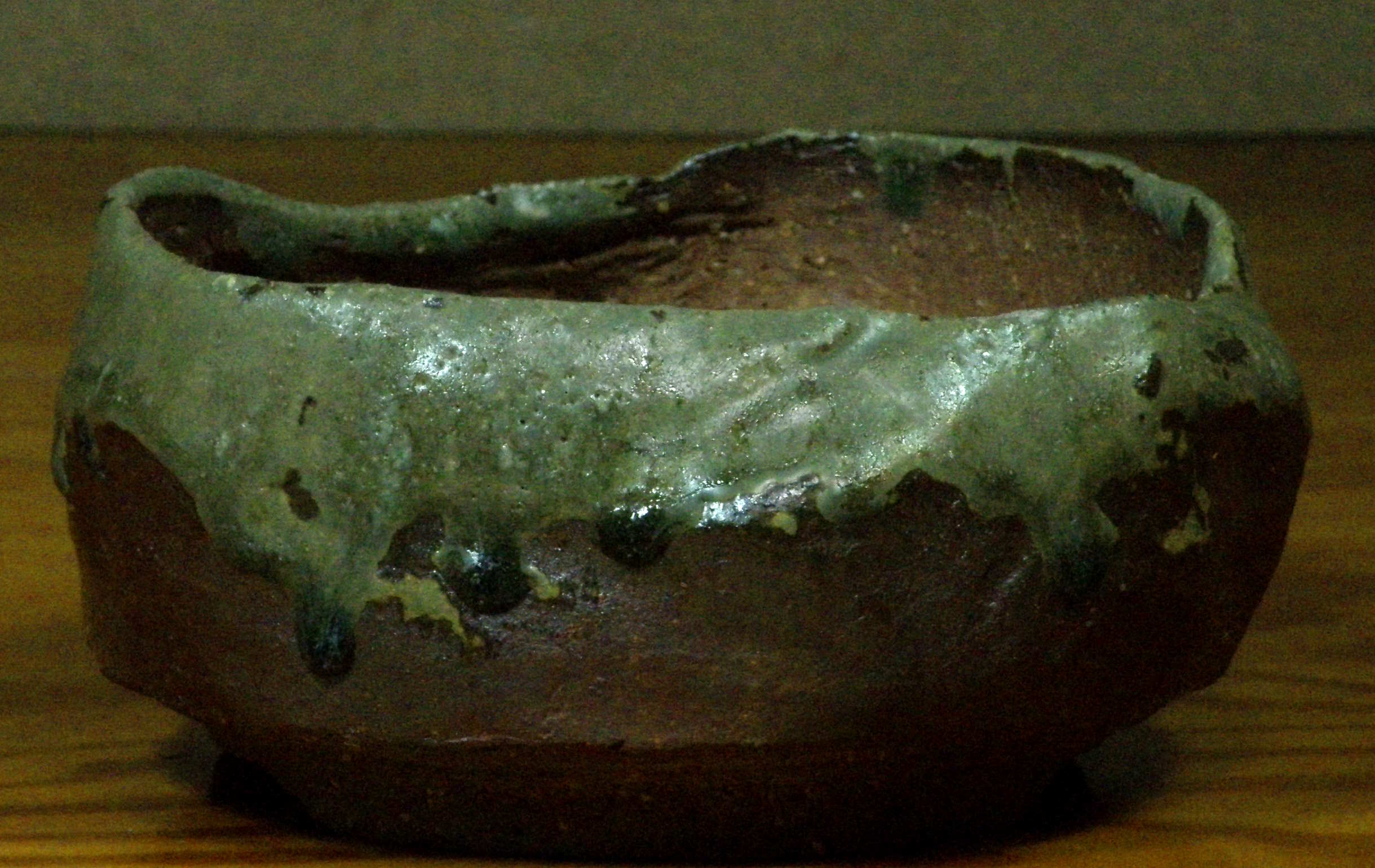
(cf “信楽の土と松灰釉の魅力”は NHK朝ドラ スカーレットのモデル女性陶芸家・神山清子さん(故人)が極め信楽で成熟した魅力である事は随分と後になってから知りました。)
I always wanted to create works that evoke harmony with nature and bring healing to people, and I was fortunate to discover Shigaraki clay and pine ash glaze early on.
- Shigaraki clay offers excellent fire resistance and a sturdy yet gentle, warm texture.
- Pine ash glaze, when reduced fired, creates a natural blue-green hue.
While many ceramics worldwide are made from white, smooth, and hard porcelain, that texture does not suit the kind of work I aim to create. Although Japan offers a variety of clays and glazes, I found that Shigaraki clay and pine ash glaze resonate with me the most. (I later learned that the late female potter Kyoko Kamiyama, the model for the NHK drama “Scarlet,” had also perfected the charm of Shigaraki clay and pine ash glaze).
詫び寂び Wabi-Sabi
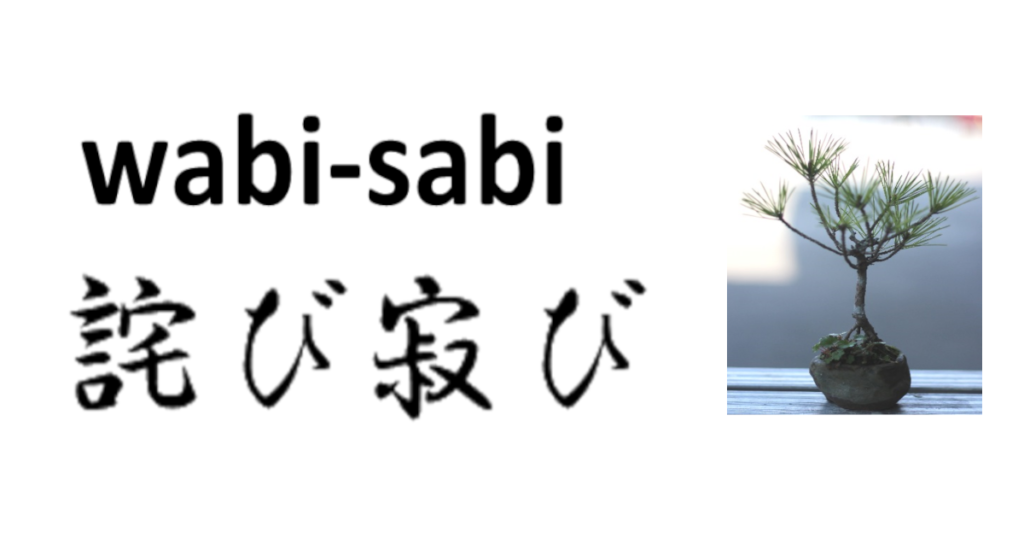
土練りを繰り返し、信楽の土と松灰釉の魅力を知ってから 取り組んだのは創作園芸鉢です。
山河や野山を散策し、草花が清楚に織り成す自然な姿、そよ風にゆらぎ四季折々に移ろう彩り、そんな自然に”詫び寂び”の美意識を感じるようになります。
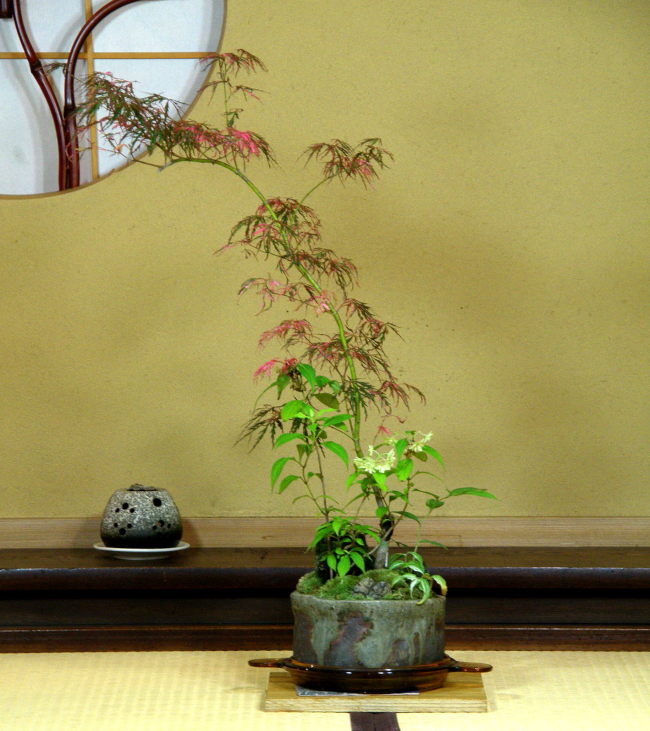
- 詫びとは、身近な小さなものにも趣を感じる事。
- 寂びとは、季節の移ろい情景の変化に風情を感じる事。
私は20年以上も山野、森林、清流に親しみ風景写真を撮ったり形の良い岩石を集めたり、それを小さな盆の上に再現したくて山野草寄せ植えや盆栽に取り組みました。
野趣で素朴でありながら、自然に和めて心の癒しになる作品作りは園芸の師匠の助力を得て景観盆栽作品は展示会や料亭、禅寺などに出品できるようになりました。
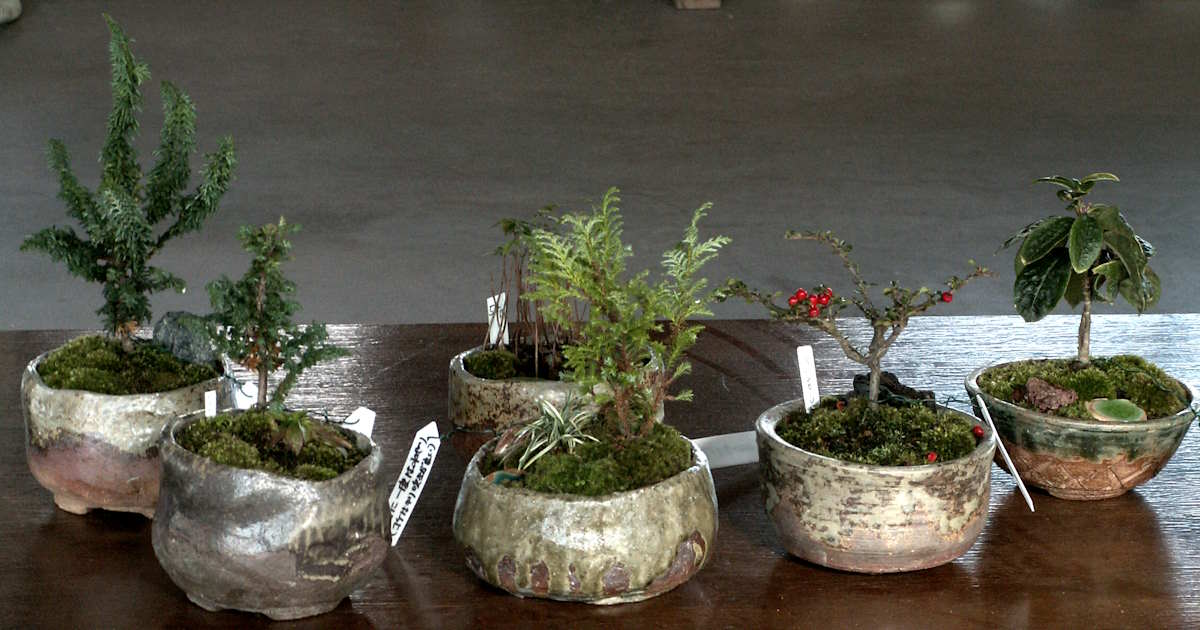
創作陶芸盆栽は自然に和めて心の癒しになります。でも盆栽樹木の世話はとても手間がかかり難しく、枯らせてしまった時のショックは大きなストレスとなり気分が落ち込みます。多くの人に親しんでもらうには不向きな趣向と思えました。
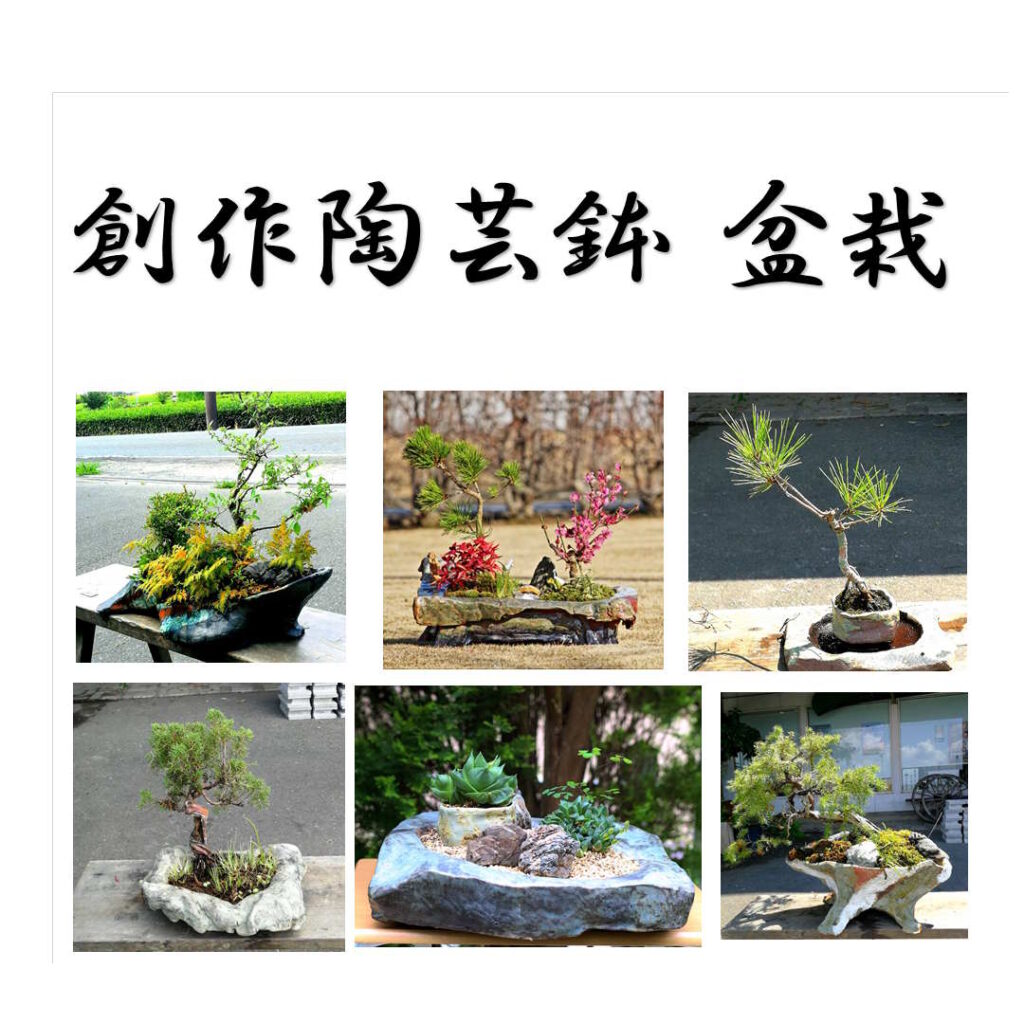
After mastering clay kneading and discovering the beauty of Shigaraki clay and pine ash glaze, I began creating artistic bonsai pots. By walking through mountains and fields, I came to appreciate the natural elegance of wildflowers swaying in the breeze and the changing colors of the seasons, which embody the aesthetic of “wabi-sabi.”
- Wabi is finding beauty in simple, humble things.
- Sabi is appreciating the beauty in the passing of time and seasonal changes.
For over 20 years, I immersed myself in nature, photographing landscapes and collecting well-shaped stones. I worked on bonsai arrangements to recreate these natural landscapes on small trays.
With the guidance of a bonsai master, my bonsai landscape works were eventually displayed at exhibitions, traditional restaurants, and Zen temples. While these creations bring a sense of peace and harmony with nature, maintaining bonsai trees is labor-intensive. The emotional impact of losing a tree due to neglect can be great, making it a difficult practice for many to enjoy.
大自然の気の流れ The Flow of Nature’s Energy
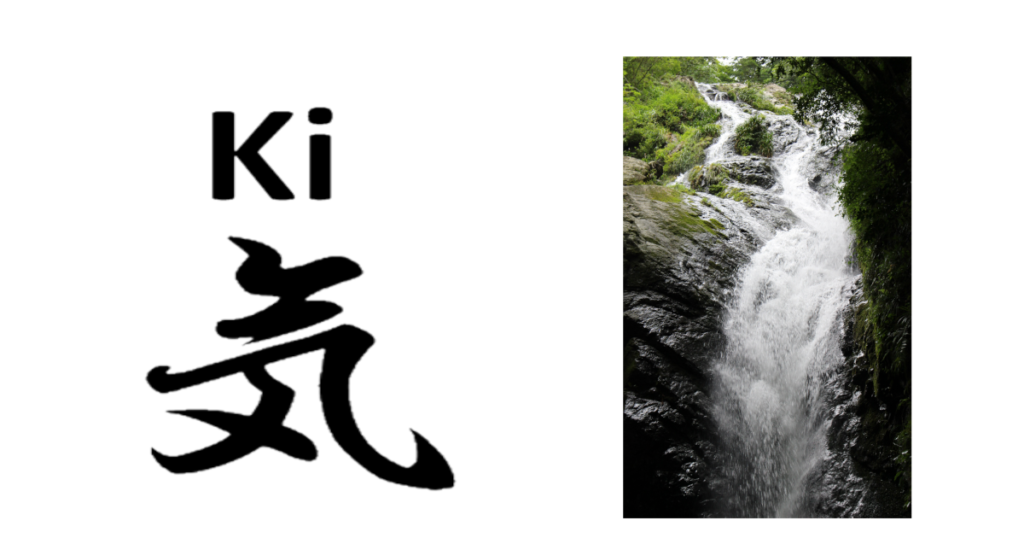
私は土練りと自然情景の観察を続けているうちに “大自然の気の流れ”と共鳴できそうな気がしてきました。掴みどころも捉えどころもない”大自然の気の流れ”にこだわり続けた訳けは 大自然の気の流れの中には 渦、回転、循環が出現しそれが創造の原動力になると予感したからです。
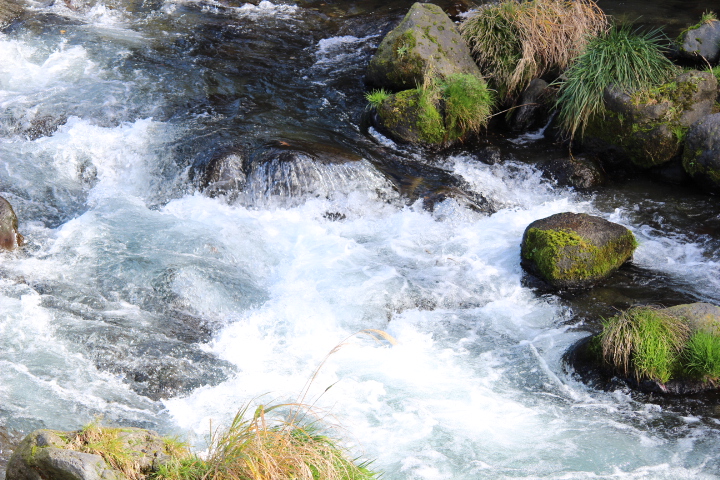
自分の作品作りに生かそうと何とか”大自然創造の気”と共鳴しようと試みます。
しかし
大自然の気の流れは荒ぶる激流で捉えどころがなく、”創造”らしきものが見えたと思っても瞬く間に消えてしまいます。自分はもがき続けて、翻弄されます。作る作品は失敗、失敗、失敗の繰り返しでした。
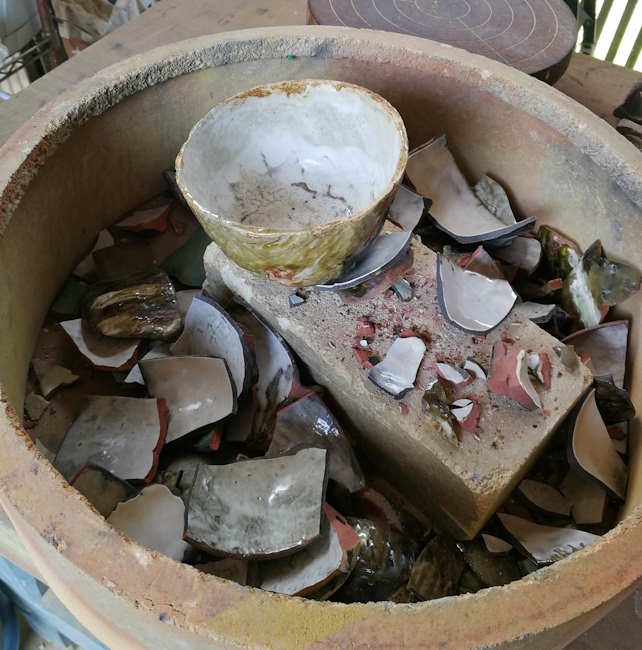
As I continued kneading clay and observing natural landscapes, I began to feel a resonance with the “ki (energy) of nature.” I was drawn to it because within the flow of nature’s energy, I sensed vortices, rotations, and cycles, which I believed could be a source of creative power. I tried to channel this “creative spirit of nature” into my work.
However, nature’s energy is like a raging torrent, elusive and difficult to grasp. Even when I thought I had glimpsed creation, it quickly vanished. I struggled, repeatedly facing failure in my attempts.
和 ”wa” (peace,harmony,Balance)
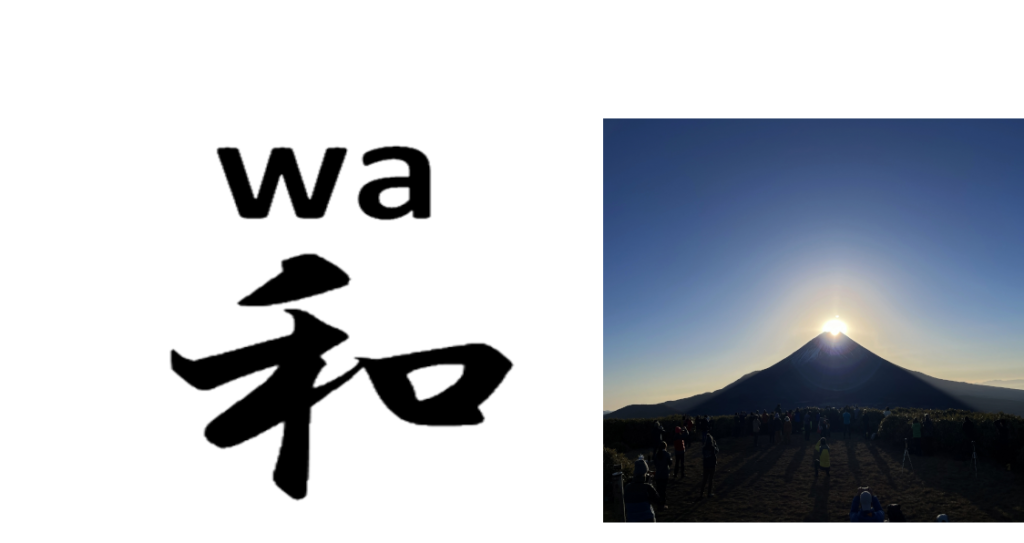
それでも人に馴染みやすく和める、身近にあるだけで何か心がワクワクと満たされる。そんな作品を作りたいという情熱を燃やし続けました。
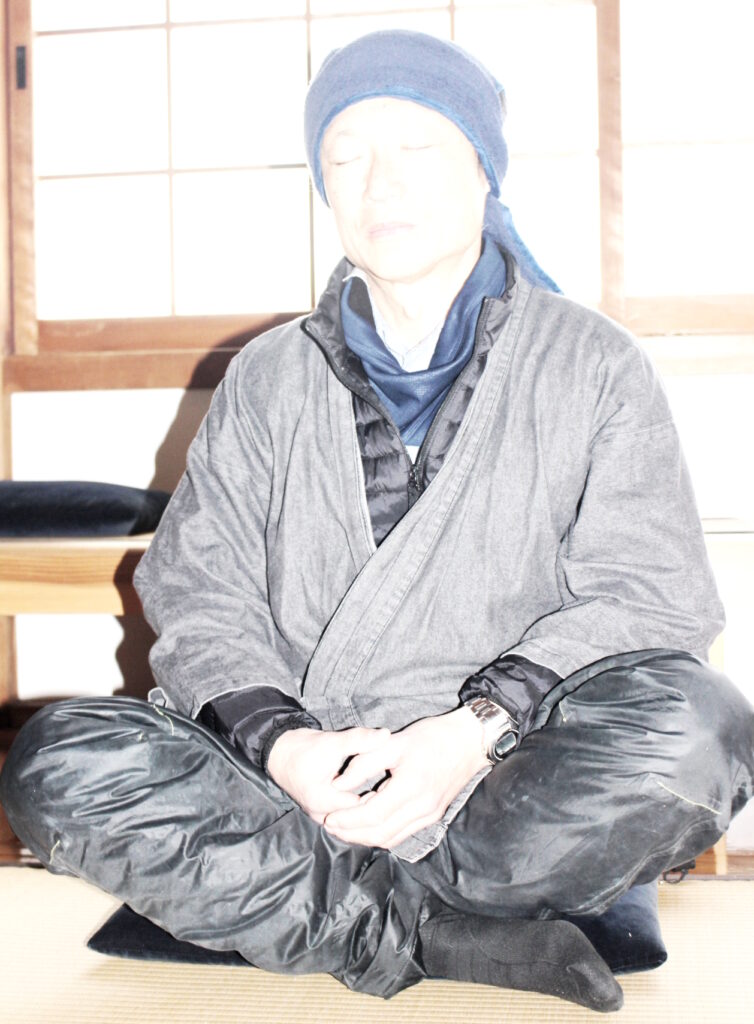
ある時から”和”を意識するようになりました。私にとって”和“は大きく3つの意味をなします。
- “やわらぎ“、”なごみ“としての和。おだやかな気持ち、心が落ち着く事。
- “平和”としての和。多様な価値観を持つ人々と向き合い受け入れる事。
- “調和”としての和。激しさと穏やかさなど相反する事でもバランスを取る事。
“和”の力を信じて、荒ぶる期の流れの激流に逆らわず身を任せます。そうすると自然と”創造の気”と同調します。”創造の気”の魅力、それは“凛とした存在感”、登山で眺める山々の景色を眺望する様な清々しさ、それが 心にグッときます。

それからは体が勝手に動きます、自分が何をどうやって作っていたのか半分自覚がありません。
我に返り、気が付いたらこれはと思える作品が出来ています。100個作って1~2個くらいですが。

Despite the struggles, my passion to create works that bring comfort and joy, and feel familiar to people, never waned. At some point, I became aware of the concept of “wa” (harmony), which holds three meanings for me:
- “Yawaragi” or “Nagomi”: A sense of calm and peace.
- “Peace”: Embracing diverse values and accepting others.
- “Balance”: Harmonizing opposites, like intensity and tranquility.
By trusting in the power of “wa,” I aligned with the “creative spirit of nature.” The clarity, like the breathtaking view from a mountaintop, resonated deeply. Often, I lose track of what I’m doing, and only after completing a piece do I realize its potential. Out of 100 pieces made, only one or two will be successful.
マインドフルネス Mindfulness
そうやってできた作品を親しき人達に診てもらったり、お祝い事に差し上げたり、茶会や宴会でお茶やお酒を振舞って使ってもらって確認します。
自然に和めて癒さえるか、凛とした清々しい存在感を感じられるか。相手にもよりますが概ね喜ばれ褒めてもらえます。
私が作ったというよりは ”大自然の創造の気”に作らされた作品ですのでうぬぼれる気持ちは起こりませんが。
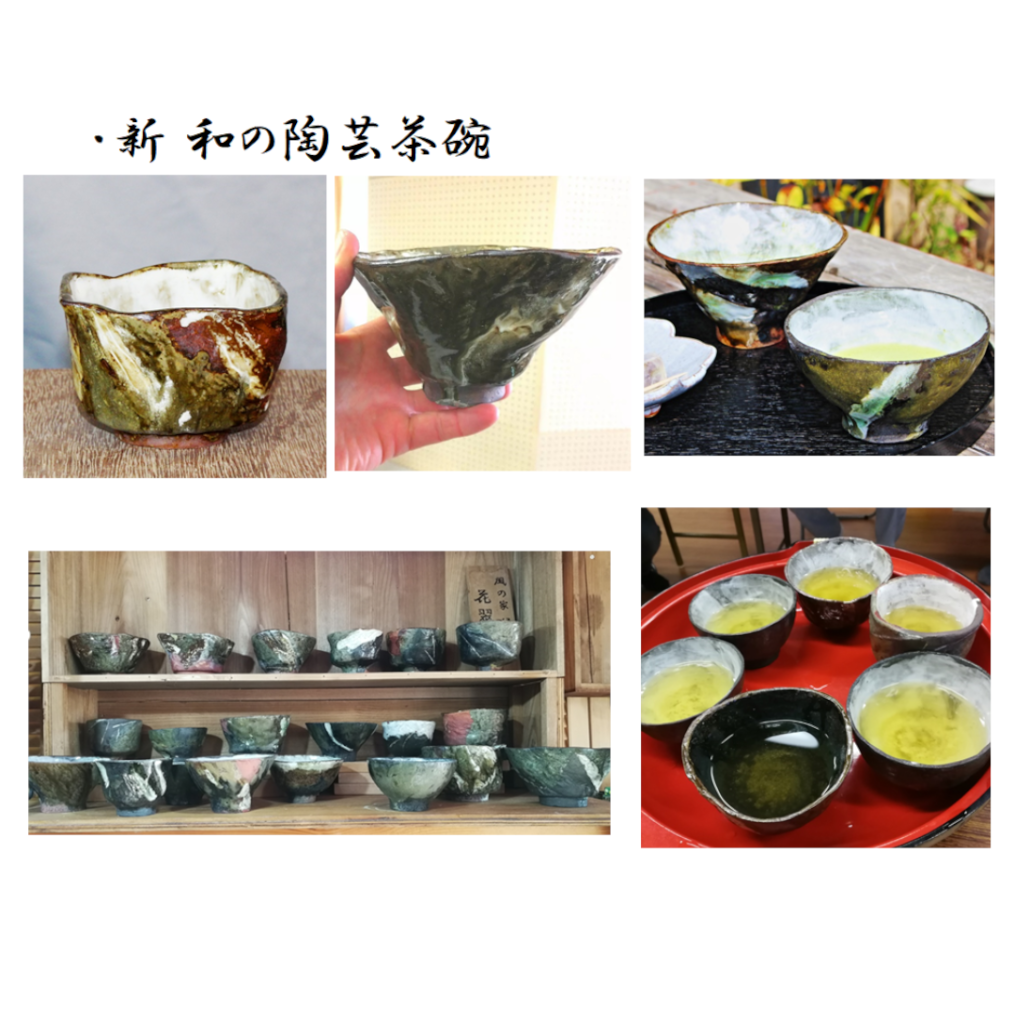
I show my creations to close friends or offer them as gifts at celebrations. I also serve tea or alcohol using my works at tea ceremonies and banquets to see if they bring a sense of calm and healing, or evoke a dignified and refreshing presence. While reactions vary, they are generally well-received and appreciated. I do not feel pride, as these pieces are not entirely my creation—they are works brought to life by the “creative spirit of nature.”

